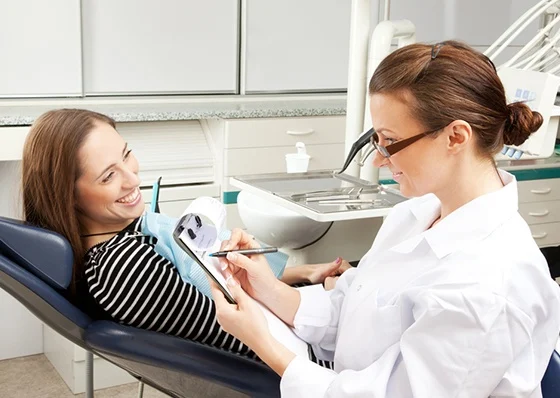What Goes in a Complete Treatment Note and Why

We all know we are supposed to have complete and accurate treatment notes, yet in reality many of us are lacking some key things in our notes. There are three really good reasons, all with different benefits, that drive the need for this.
The one that most likely that pops into many people’s minds first is to cover ourselves from a legal standpoint in case of any disputes brought forward. The second reason is, of course, to remind ourselves of our patient’s history of care, thereby helping us and any other providers in the future provide the best care possible for the patient. Lastly – and tied to both the first and second reasons – is to discover if an issue is present with a material we are using.
So what should go in your treatment notes? Keep reading to find out.
Dental Treatment Note Checklist Must Haves
Clearly what should be in your treatment notes will vary depending on the type of procedure being documented. However, there are certain things that should be in every treatment note.
These are the five things that should be in every note:
- The first is documentation that the patient’s health history was reviewed and/or updated.
- The second thing to go in every treatment note is any chief complaint reported by the patient and the plan developed to address this chief complaint. Ideally this chief complaint should be documented in the patient’s own words if possible.
- The third item that should be in every treatment note is what is next for the patient. For example, it could be their hygiene visit, a restorative visit, treatment at a specialist, or referral back to the office that normally manages their care if you are specialist.
- The fourth thing that should be in every treatment note is any comments or events out of the ordinary that occurred during the patient’s visit. If it is a comment made by the patient, just like a chief complaint it should ideally be documented in their words if possible.
- The fifth thing you need in every note is a diagnosis or, at minimum, a differential diagnosis and a plan to get to a definitive diagnosis.
Treatment Note Additions for Anesthetic
When it comes to any procedure that involves anesthetic, there are four more things that should be in the note:
- The first thing to go in the note is blood pressure. You really should take this and document your reading prior to anesthetic (it is also something you should be doing with every new health history).
- Second, of course, is the type of and how much anesthetic you gave.
- Third is the type of injection you gave and how much as well as what kind of anesthetic for each different type of injection you gave during the visit you are documenting.
- Finally, if you are like me and have a few patients that never want anesthetic (even for things like crowns), I would document if anesthetic was declined if the patient chooses to do so.
Other Treatment Note Additions
Next let’s look at things that belong in our notes depending on the type of visit we are documenting.
Exams
You will first want to document both what kind of exam was done (limited, periodic, comprehensive, etc.). Then you’ll want to document any significant findings, not just an exam was completed. For instance, if you did pulp testing, you should document what tests were done (thermal, percussion, electric, etc.) and on which teeth as well as the results. You do not want to be vague, writing, for example, “Pulp testing was WNL.” Rather you should be specific in your note, such as writing, “Endo ice on teeth numbers 3,5,12 and 14 produced a positive non-lingering response that was similar on all teeth and appears WNL.”
Restorative
With restorative treatment notes, I believe it is really important to document all the materials used. For example, you will want to document the composite, bonding agent, cement and shade used. If you are using a CEREC, you should document the block. You want to document literally everything that goes in the tooth or teeth you are restoring.
While this may sound like a pain in the you-know-what, the reasoning behind this is the fact that we will all have failures. While these failures are due to our technique and independent of the materials we used, the fact of the matter is that sometimes they are directly tied to a material flaw. Thus, documenting everything we use helps us figure out what caused any problems we may run into. Now, I am not only pointing to materials as the cause of problems. The fact of the matter is that while we are fortunate in the fact that we have a lot of great materials to work with today, even the greatest materials from the greatest companies have issues from time to time despite their best efforts.
It is also critical, as I have already stated, to document the diagnoses (i.e. decay, fracture, etc.) that is driving the treatment you are preforming. And, of course, it is a great idea to document who assisted you during the procedure.
Hygiene
Finally, let’s cover hygiene notes. It is worth repeating that, just like with restorative notes, you need a diagnosis. To get to this diagnosis, you need to be doing and documenting full periodontal charting at least one time a year and documenting any changes at every visit.
Other thing you will want to address are the patient’s home care and any oral hygiene instructions your team gave the patient. You should also document the recommend re-care interval. Lastly, document any hygiene recommendations, such as fluoride, and if the patient accepted them.
While I hope this discussion has been helpful, keep in mind that you can put more in your notes if you so choose. Remember, if you are trying to look back in time at what you did, the more detailed and well-put-together your information, the better off you’ll be. No one really ever says, “Man, I wish I had less detail in regards to what took place.”
(Click this link for more dentistry articles by Dr. John Carson.)
John R. Carson, D.D.S., P.C., Spear Visiting Faculty and Contributing Author – www.johncarsondds.com
SPEAR campus
Hands-On Learning in Spear Workshops
With enhanced safety and sterilization measures in place, the Spear Campus is now reopened for hands-on clinical CE workshops. As you consider a trip to Scottsdale, please visit our campus page for more details, including information on instructors, CE curricula and dates that will work for your schedule.

By: John Carson
Date: August 1, 2016
Featured Digest articles
Insights and advice from Spear Faculty and industry experts


